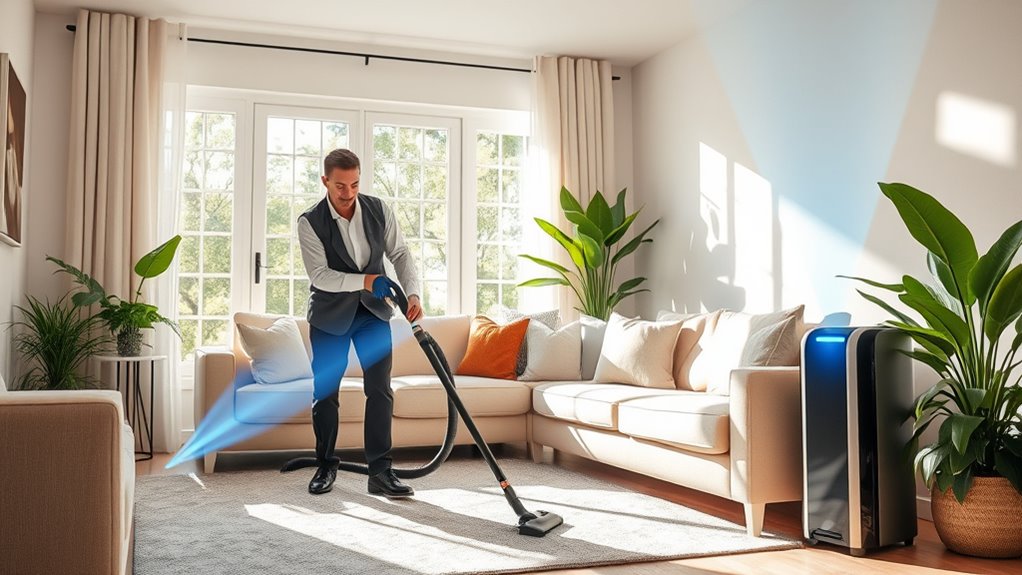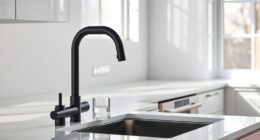To improve indoor air quality and remove allergens effectively, clean regularly with damp cloths to trap dust mites and pet dander. Use HEPA-filter vacuums for carpets and upholstery, and wash bedding and curtains frequently. Keep humidity below 60% with dehumidifiers, fix leaks promptly, and ensure good ventilation to prevent mold growth. Maintaining these strategies can help you breathe easier and reduce allergy symptoms—discover more tips to create a healthier home environment.
Key Takeaways
- Regular dusting with damp cloths and vacuuming with HEPA filters removes airborne allergens from surfaces and upholstery.
- Maintaining indoor humidity below 60% using dehumidifiers inhibits mold growth and reduces mold spores.
- Frequent washing of bedding, curtains, and pet items minimizes dust mites and pet dander buildup.
- Ensuring proper ventilation and fixing leaks prevent moisture accumulation, lowering mold proliferation.
- Using air purifiers with HEPA filters continuously filters airborne allergens, enhancing indoor air quality.

Indoor air quality considerably impacts your health, especially when allergens like dust mites, pet dander, and mold spores circulate freely. Poor air quality can lead to allergies, asthma, and other respiratory issues, making it essential to adopt effective cleaning strategies that target these invisible threats. One of the most important steps you can take is investing in air purification devices. High-efficiency particulate air (HEPA) filters are particularly effective at capturing tiny allergens that standard vacuum cleaners might miss. By continuously filtering the air in your home, air purifiers help reduce airborne allergens, creating a cleaner, healthier environment. Regularly maintaining and replacing these filters guarantees they function at their best, providing ongoing relief from allergens.
Investing in HEPA air purifiers and maintaining filters is key to reducing airborne allergens and improving indoor air quality.
Mold mitigation is another critical aspect of improving indoor air quality. Mold thrives in damp, poorly ventilated areas, often hidden behind walls or under floors. To prevent mold growth, you should control indoor humidity levels, ideally keeping them below 60%. Using dehumidifiers in basements, bathrooms, and kitchens can greatly limit mold development. Additionally, fixing leaks promptly and ensuring proper ventilation helps eliminate the moisture that mold spores need to flourish. Cleaning visible mold with appropriate solutions, such as diluted bleach or commercial mold removers, is essential to prevent spores from becoming airborne and worsening allergy symptoms. Maintaining good air circulation also helps disperse humidity and reduce mold growth.
When it comes to allergen removal, your cleaning routine plays a vital role. Regular dusting with damp cloths prevents dust mites and pet dander from settling and becoming airborne. Vacuuming with a HEPA filter-equipped vacuum cleaner effectively removes allergens from carpets and upholstery. Washing bedding, curtains, and pet bedding frequently also reduces dust mite populations and pet dander. These steps, combined with good ventilation practices, help keep allergens at bay and improve overall indoor air quality.
In addition to physical cleaning and air purification, maintaining a clutter-free environment minimizes places where dust and allergens can accumulate. Avoiding heavy drapes and plush toys, which trap dust, can make cleaning easier and more effective. By staying proactive with mold mitigation and employing air purification strategies, you considerably reduce the presence of indoor allergens. These efforts not only improve your indoor air quality but also promote better respiratory health and comfort for you and your family.
Frequently Asked Questions
How Often Should Allergen Removal Treatments Be Performed?
You should perform allergen removal treatments every 3 to 6 months, depending on your cleaning frequency and allergen buildup. Regular cleaning helps prevent dust, pet dander, and other allergens from accumulating, which can worsen allergies or asthma. If you have pets or allergies, consider more frequent treatments. Staying consistent with your cleaning schedule guarantees better indoor air quality and reduces allergen levels effectively.
Are Natural Cleaning Products Effective Against Airborne Allergens?
Some might doubt natural cleaning’s allergen effectiveness, but it can be quite effective against airborne allergens. Natural cleaning products often use plant-based ingredients that break down allergens and reduce dust, mold, and pet dander in the air. While they might not be as potent as chemical cleaners, regular use can improve indoor air quality, making your space healthier. So, yes, natural cleaning products can help manage airborne allergens effectively.
Can HVAC Filters Completely Eliminate Indoor Allergens?
HVAC filters can’t completely eliminate indoor allergens, but proper allergen filtration substantially reduces them. You should prioritize regular HVAC maintenance, like changing filters and cleaning ducts, to improve allergen removal. High-efficiency filters, such as HEPA filters, capture more airborne particles, making your indoor air healthier. While filters help, combining this with other strategies like regular cleaning and humidity control creates an all-encompassing approach to improving indoor air quality.
What Are the Signs of Poor Indoor Air Quality?
Think of your home as a clear lake, suddenly clouded. Signs of poor indoor air quality include persistent coughing, sneezing, and stuffy noses—airborne irritants that won’t settle. You might notice a musty smell or visible mold, indicating mold detection issues. If your eyes itch or you’re constantly fatigued, these are clues your indoor environment is compromised, and your air needs better filtration and cleaning to restore clarity.
Do Air Purifiers Remove All Types of Indoor Allergens?
Air purifiers with HEPA filters can substantially reduce many indoor allergens, including dust mites and pollen. However, they don’t remove all allergen types, like certain VOCs or mold spores. To maximize their effectiveness, use them consistently and combine with other cleaning methods. While they help improve your indoor air quality, remember that no single device can eliminate every allergen completely. Regular cleaning remains essential.
Conclusion
By implementing effective cleaning strategies, you can considerably improve your indoor air quality and reduce allergen levels. For example, regular dusting and vacuuming can cut airborne allergens by up to 50%. Keeping your home allergen-free not only eases allergy symptoms but also creates a healthier environment for you and your family. Don’t underestimate the power of consistent cleaning—small efforts lead to big improvements in your indoor air quality and overall well-being.








